In order for you to make money through your affiliate site, people need to be able to find it in the first place.
It’s you and hundreds, thousands, or even more websites competing for the same result.
So what can you do to make sure that your affiliate site is the one getting the initial traffic and not your competitors?
Optimizing the content on your affiliate site will help you take big steps toward winning more traffic.
However, what many don’t realize about optimizing your content is that a lot of the optimization work is done before you start writing, not after.
Here are some content optimization methods you should be putting into place before, during, and after you write your content to help pull more people to your affiliate site.
1. Keyword research – Are you targeting worthwhile keywords?
Any content you create should be off the back of doing keyword research.
Without doing this step first, you run the risk of writing a really awesome article that absolutely no one will read because they’re not searching for the topic in search engines.
It may be all well and good to write a detailed article about the benefits of naming your dog Spot, but if no one is searching for this kind of information you’ll struggle to generate much traffic from it.
Now imagine that all of your affiliate site’s content is like this.
Simply put, you want your site’s content to be targeting keywords if you want to bring in traffic to push down your funnel.
You don’t want to waste your time, so before you start writing anything you want to look into the keywords surrounding your chosen niche.
This is why keyword research is a big part of effective SEO and content optimization.
The main things you’ll be looking for when doing keyword research are:
- Keyword volume
- Search intent
- Potential difficulty to rank for a keyword
- Niche relevancy
There are various tools available to help you get this information.
Although many of the well known keyword research tools are paid for, there are some great free versions available too.
I personally use a mixture of Ahrefs Keywords Explorer and Google Keyword Planner (depending on the intent of the content).
When you start your keyword research you’ll be looking for keywords that are relevant to your niche, have a high number of monthly searches, but don’t have a lot of ranking competition.
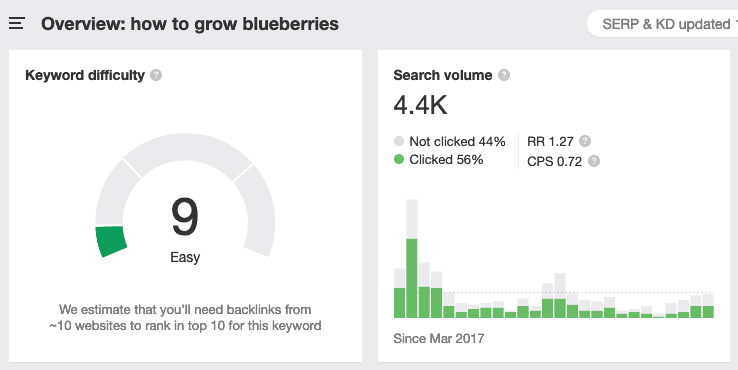
For example, the keyword “how to grow blueberries” has 4,400 monthly searches and according to Ahrefs has a ranking difficulty of 9 (out of 100).
Writing content centered around this term is more likely to yield higher amounts of traffic to your site than writing content that targets a keyword with 50 monthly searches and a difficulty of 75.
There will normally be a number of closely related keywords around one topic (growing blueberries, how to grow blueberries in a pot, etc.) all with their own monthly search volumes and difficulties.
Make a list of all the keywords you find and their metrics so you can make a content plan based on your findings.
SERPs and search intent
When choosing keywords for your content to target, always check what the SERPs show.
You’ll do this check to determine:
- What the search engine thinks the search intent behind the keyword is, and therefore what results it gives.
- What the SERPs actually look like.
Firstly, some keywords have more than one meaning or intent.
For example, you wouldn’t want to write a detailed article about apples only to find that the search intent of the keyword “apple” is to find a certain well known company not entirely related to the fruit.
The easy way to work around this is to simply search for your intended keyword in search engines and take a look at the results.
If your piece of content would be competing with product pages, there’s a good chance you’re not matching the search intent correctly.
Another aspect of assessing search intent is to see what most of the searchers are trying to achieve by searching for a certain keyword.
What is the intent?
Are they looking for information on a topic or actively looking to purchase it.
Here’s a useful table that describes this difference.
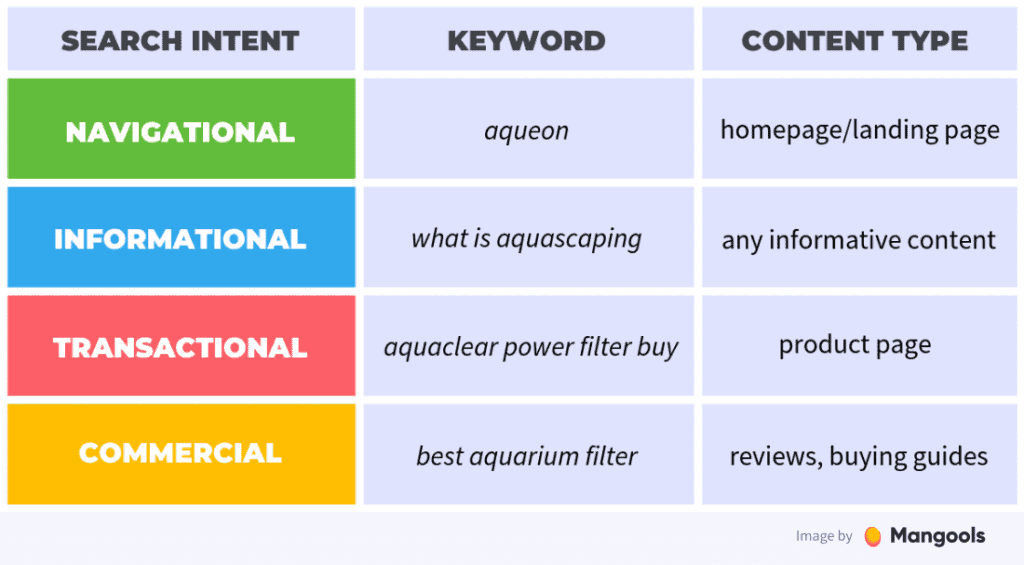
As you can see, the different keywords represent different search intent.
As a result, the content you create to rank for these keywords will also be different from each other.
Secondly, you’ll want to see if your chosen keyword returns featured snippets, ads, and other results that take up valuable SERP real estate.
More on featured snippets later, but the main point is that these results take up a lot of room in the SERPs and can mean that, even if you rank #1, you’re not guaranteed good traffic.
Having this knowledge of what the SERP actually looks like can help you choose what keywords to start targeting.
2. Low hanging fruit Vs high competition keywords
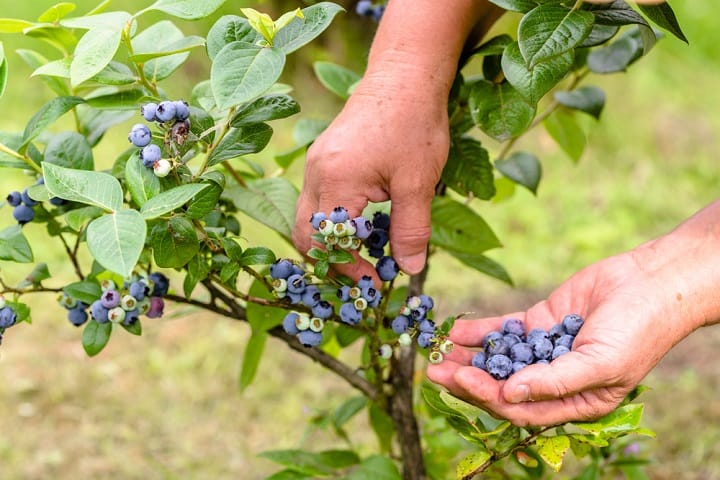
Continuing the topic of keywords, they generally fall into three buckets.
- Low hanging fruit
- High competition
- Everything in between
We’re going to talk about the first two.
Low hanging fruit are keywords with a good monthly search volume and a very low ranking difficulty.
Generally, there isn’t much competition to rank for these keywords so your content has the potential to end up ranking well and bringing traffic to your affiliate site quite quickly.
On the other hand, high competition keywords are as you would expect; difficult to rank for because everyone is trying to rank for them.
This can be due to a mixture of things such as a very high search volume, a particularly profitable keyword, or because the niche you have chosen is challenging.
Initially, you would think that low hanging fruit keywords would be the obvious option for your affiliate site content, but that isn’t always the case.
There are a few things to weigh up before you completely write one or the other off (hint: Don’t write either off, ever!)
The “authority” of your affiliate site
Is your site quite new, or has it been around for years and regularly receives a good amount of traffic?
Is it seen as one of the bigger players in your niche?
The authority your site has can help determine how easily your content will rank for keywords.
You can get a measure of a site’s authority with Moz’s Domain Authority (DA) score. It’s not an official Google metric for evaluating sites, but is generally considered a good indicator of a site’s authority in the SEO industry.
It is calculated mainly by considering the number of other established websites linking to a certain domain.
The higher the domain authority of a site, the better chance it has of ranking for a high competition keyword.
If you have a lot of authority (for example DA 50+) going for high competition but high return keywords might not be such a bad idea.
Alternatively, if your site is newer (DA 10-20) then you will probably have better luck targeting low hanging fruit keywords, especially if you need to gain traffic quickly.
Once your site gains more traffic and backlinks, and your DA score increases, you can rank for higher competition keywords faster.
How much content you already have

When you first start your affiliate site you have endless options of topics to write about.
As you write more content, your options for new topics to write about decrease.
If you’ve already covered all the low hanging fruit keywords, it might be time for you to move on to higher competition ones.
If you’re hesitant to enter the high competition game, re-evaluate your existing content and see if any improvement can be made to gain more traffic.
You should also be doing keyword research regularly so you can discover any new low hanging fruit keywords.
If your low hanging fruit content is performing well and you’ve covered all bases, take the step to higher competition keywords.
How patient you are
Simply put, if you want results yesterday then your best bet is to create content around low hanging fruit keywords.
By their nature, you’re more likely to see the needle move and start getting traffic sooner rather than later.
However, if you’re willing to play the long game, high competition keywords could be worth the time investment further down the line.
3. Building Topical Relevance With The Right Keywords
One of the keys to building a successful affiliate site that’s considered n authority on a specific topic is to build topical relevance.
Google generally prefers ranking sites that are considered an authority on a topic.
For example, a site that generally publishes content about dog food and training will have a hard time ranking for a keyword like “On-Page SEO Tips For Bloggers” as compared to a digital marketing and SEO blog that’s an authority in the SEO niche.
How do you build topical relevance?
By covering a topic comprehensively from all angles.
This means you’ll have a group of primary target keywords for your content strategy.
And for every keyword, you’ll have multiple related keywords that you need to cover in your content so that it becomes a valuable resource for your readers.
An easy way to find such keywords is to look for the questions your audience is asking about your topic.
Instead of adopting a narrow keyword-based approach, adopt a broader topical approach.
For example, if you have an affiliate site about weight loss products, don’t limit yourself to the commercial keywords only. Instead, explore the questions dog owners have about dog food and nutrition.
For example, why dog don’t eat, the best food for active dogs, what to feed your dog when it’s sick, foods you should avoid giving to your dog, foods that can cause different dog diseases, foods that can cure different dog diseases, so on and so forth.
When you cover a topic comprehensively, Google considers your site an authority on it and gives you preference over general sites.
4. Check The Potential For Featured Snippet Rankings
You can find featured snippets in Google’s search results.
Featured snippets appear at the top of search results (which is why they’re called position zero) and enable searchers to find concise answers to their questions in the SERPs without having to click through to any of the results.
Featured snippets enable searchers to find concise answers to their questions in the SERPs without having to click through to any of the results.
Initially this may sound bad for affiliate site owners trying to increase their traffic, but that isn’t always the case.
Although featured snippets are useful in getting quick answers, they also command a lot of clicks from searches looking for more than just a quick answer.
In fact, a study by aHrefs revealed that in searches with featured snippets, clicks to the first organic result dropped below 20%, with featured snippets claiming 8.6% of the clicks.
Featured snippets also tend to take up a lot of the SERPs real estate.
Let’s take “how to grow blueberries” as an example. This is what the SERP looks like:
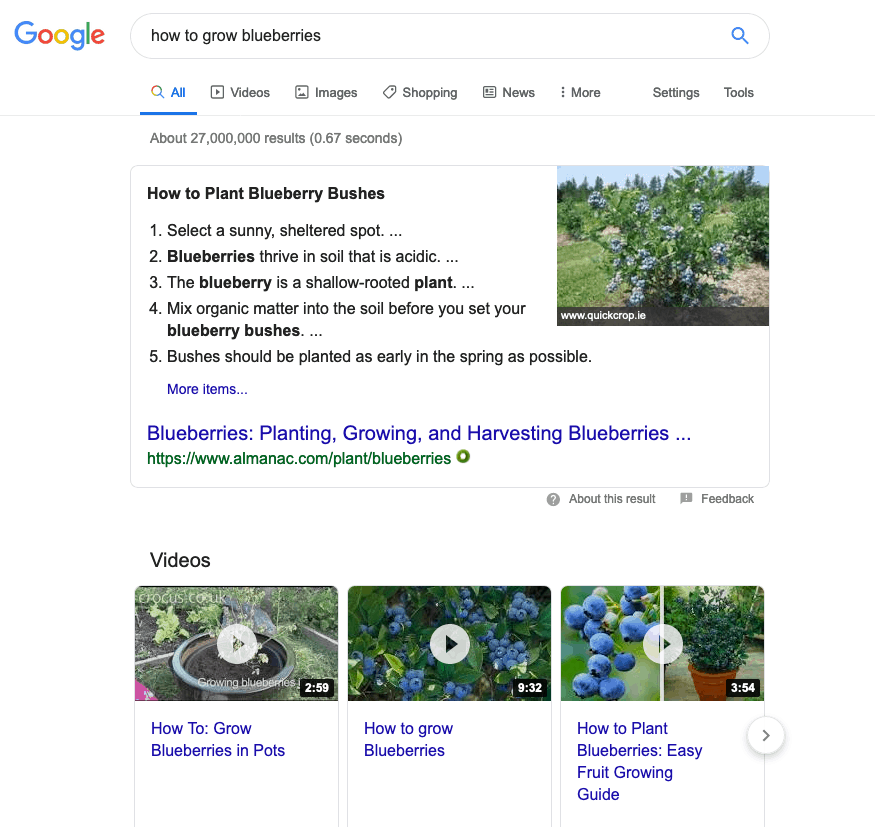
The top result is a list featured snippet that takes up a lot of space, the second displays related videos.
You have to scroll down before you get the result that is technically ranking #1.
If the featured snippet provides the information the searcher is looking for, they’re more likely to click than scroll down to the other results.
So, we know that featured snippets can mean good things for bringing more traffic to your affiliate site.
However, if you know that the keyword your content will be targeting has a featured snippet, you can optimize your content to have a better chance of landing the snippet.
If you’re not sure how to optimize your content to nab the snippet, take a look at the content that already has it.
Don’t try to reinvent the wheel with what you write, as Google is looking for content that fits the structure of the snippet and not the other way round.
List snippets tend to be formed of numbered lists, text snippets answer a question concisely, and so on.
Take a look at what your competitor is doing and do it better.
Generally, here are a few tips to increase your chances of making it to the featured answers snippet.
- Create your question in question/answer format. If you’re writing a blog post, create an FAQs section with precise answers to the most common questions of your audience starting with the basic definition of your topic.
- Note the down the questions in the “People also ask” section of SERPs for your target keyword. These are the most popular questions of your audience and answering them will improve your chances of getting position zero.
- Write short and precise answers (you can expand them later) so that Google can feature them easily.
- Use step by step guidelines, use lists.
- For comparisons, use tables.
- Follow the general on-page SEO best practices
4. Follow The On-Page SEO Best Practices
When it comes down to writing your keyword targeted content, there are a few more easy things you can do to properly optimize it.
Use The H1, H2, and H3 Tags For Headings
Header tags, or H tags are used to define headings and subheadings throughout the text.
In HTML they appear as <h#> and go from H1 down to H6.
Your affiliate site’s CMS will determine if you need to add H tags in HTML or not.
From a design sense H tags affect how a heading and subheading appears.
Generally H1 headings will be the biggest and most prominent, down to H6 being the smallest.
But from an SEO and optimization sense H tags send signals to Google to help determine what your content is about.
The most important H tags are H1 and H2.
On any one page there should only ever be one H1 tag.
Use Image Alt Tags
We all know how daunting a wall of text can look, so if you want to make your content appealing you’ll want to break it up with images.
Not only do images help readers navigate your text more easily, they can also be used to optimize your content through alt tags.
Firstly I should explain that Google and other search engines can’t actually see images.
They don’t know what images are depicting, so we need to help the search engines to determine what the images are. We can do this by using alt tags.
Alt tags are, in short, a description of the image.
Alt tags also serve the purpose of making your content more accessible to those who are visually impaired.
Audio descriptors use alt tags to describe what an image is to someone who can’t see it, so bear this in mind when crafting your image alt tags.
As search engines pay attention to alt tags to gain a better understanding of your content, you can use them as another opportunity to use your keywords.
However, if you want your content to be accessible to all audiences, you need to strike a balance between including your keywords and properly describing an image.
For example, if you’re writing about growing blueberries, you could use an image of a blueberry bush growing in a pot and use the alt tag “image of blueberries growing in a pot”.
This example has a variation of the keyword “growing blueberries” but would still describe the image to visually impaired visitors.
This heading will be the most important, and send the strongest signals to Google as to what your content is about.
In most cases your H1 heading will be the title of your content.
After that you will use H2 tags for the subheadings in your content (take a look at the main numbered subheadings in this post).

H2 tags are the next most important as Google also pays a good amount of attention to them.
This is because subheadings generally help give a better understanding of what the content is about, both to the reader and to Google.
You can use as many H2 headings as you need to write a good piece of content.
It’s also a good idea to fit your main target keyword or variations of it in one or two H2 headings (but only if it works naturally. Don’t try forcing keywords into your headings).
From there you have H3 headings (see the “Use H Tags” heading above as an example).
Although these are also important, they don’t carry as much weight as H2 headings. H3 headings and below generally serve more purpose in sectioning off text and should be used more with the mindset of creating good content than creating optimized content (again, see the way I’ve used the H3 heading above for this subsection about H tags).
If your affiliate site is on WordPress there are a few SEO plugins you can use that can help you optimize your H tags. Yoast SEO is one example, as it points out if you have used your keyword or not in any of your headings.
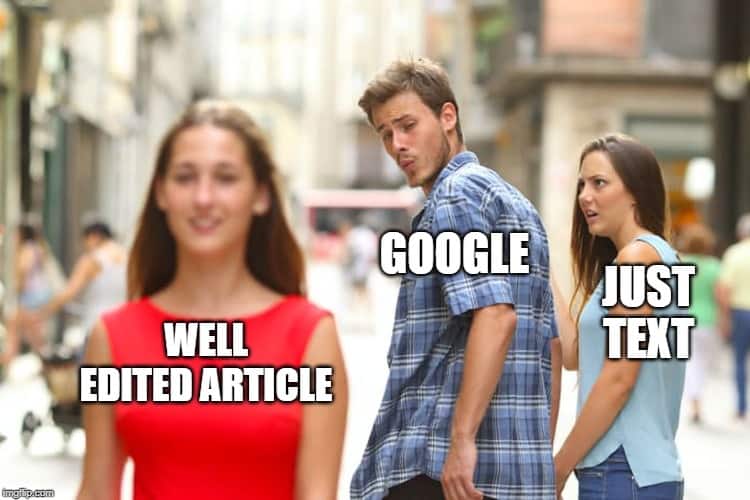
Use Search Engine Friendly URLs
The slug is the part of a URL that uniquely identifies a page. Each page on your website has a unique slug.
Here are a couple of examples:
https://www.buzzlogic.com/business/best-display-ad-networks/ The slug is “best-display-ad-networks”
https://www.buzzlogic.com/business/website-investing-guide/ The slug is “website-investing-guide”
Slugs are important because they are one of the factors used by search engines to rank a page on your affiliate site. The slug helps search engines determine what a page is about.
Slugs that are easy to read also help visitors determine what your content will be about. Take the examples above, you can easily tell what the pages are about just by looking at the slug.
When it comes to optimizing your slug, the first step is to include your target keyword.
If you want to rank for “how to cook potatoes” and you’ve written a post titled “Learn How To Cook 5 Different Types of Potatoes”, many CMS will automatically create the following: “learn-how-to-cook-5-different-types-of-potatoes”.
However, an optimized slug would be “how-to-cook-potatoes”.
Here are a few more tips to getting your slug spot on:
- Use dashes “-” to separate words. Avoid using underscores “_”, or no spaces at all!
- Keep all characters lowercase. No need to use capitals.
- Aim for a shorter slug. This isn’t always possible, depending on your title and keywords, but shorter slugs are easier to read.
- Get rid of stop words if you can. Examples of stop words are “a,” “and,” “but,” “how,” “or,” and “what.” It doesn’t always work to remove them, but if you can then you should.
Combine all these tricks together and you’ll be able to create an optimized slug for your content.
Use Link Magnets In Your Content
The number of backlinks pointing to a site is among the top search ranking factors and one of the main off-page SEO strategies.
This is why acquiring HARO links (links from high-authority websites) is such a powerful link building strategy!
However, to improve your chances of getting backlinks, you need to create link-worthy content that carries different link magnets or hooks that can help you naturally attract backlinks.
What are they?
- Lots of data, numbers, stats, and research-backed arguments. Make sure every opinion in your content is backed by solid research
- Infographics and images with text content that can be used by other blogs int heir content. This is one of the major sources of backlinks for any top blogs.
- Primary data like surveys and research studies that other site owners and content creators can reference.
- Original example, case studies, and success stories
Adding these things to your content not only makes it significantly more valuable but also improves tour chances of getting backlinks without actively building them.
Bonus section: What to do once your content is optimized

Now that you’ve optimized the content on your affiliate site, you still need to make sure the content drives visitors to your affiliate links.
Amazing content will mean nothing if it doesn’t drive visitors into your funnel, and ultimately, earn you money.
Here are a few things to do once you’ve finished optimizing your content:
- Know where in the funnel your content sits.
- Do you have Amazon affiliate links throughout your content? Or does your content link out to specific review posts that contain your affiliate links? Make sure the way you craft your content suits where it sits in the funnel to properly drive visitors to do what you want.
- Include “Call To Actions”. Going on from the previous point, including proper CTAs will help push visitors closer to your affiliate links. Tell your visitors what you want them to do by using CTAs throughout your text.
- Start offsite optimization. A whole topic on its own, but writing great optimized content is only one side of the coin. To step things up a gear you can focus on offsite optimization methods like building backlinks from trusted websites, social media promotion, and forming valuable relationships with others in the industry.
The main goal of properly optimizing your content is to make sure people can find your affiliate site in the first place.
Optimizing helps search engines figure out what your content and site is about, so they can deliver it to people searching in your niche.
The more visitors you can get to your site via relevant keywords that you’ve optimized for, the higher your chances of them moving further down the funnel to purchase through your affiliate links.
Do the prep work before you start writing to ensure that every bit of content you create for your affiliate site helps drive results.
About Emma
Emma White is part of the SEO team at Multi Layer Media. Her background is in art and photography, meaning she can call on her creative experience when tackling content strategies.
Planning, editing, and optimising content to make sure it reaches its full potential is a core part of her daily work, helping clients achieve contextual rankings. When she’s not on the job she’s probably looking after her (many) houseplants..
[ad_2]
